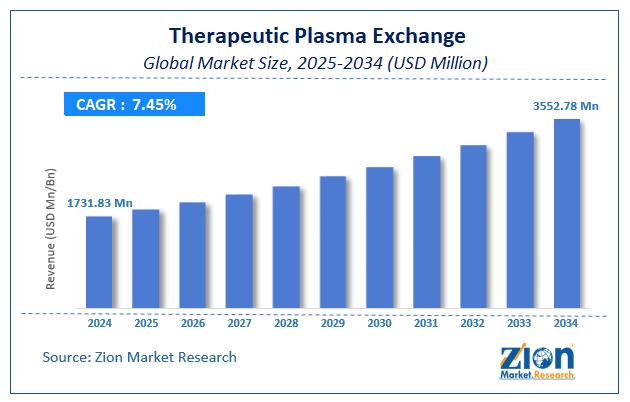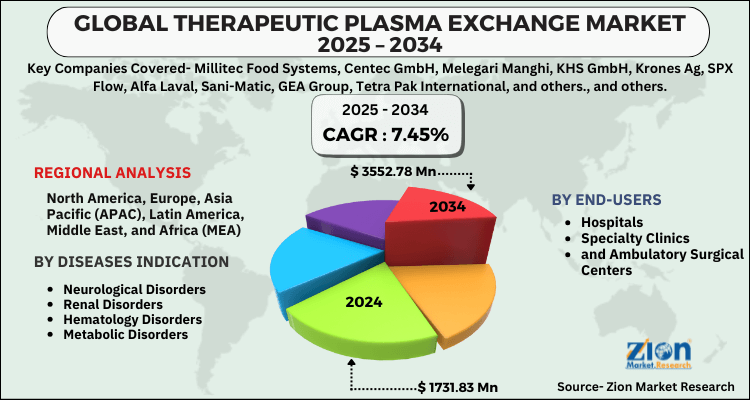Global Therapeutic Plasma Exchange Market Size, Share, Growth Analysis Report - Forecast 2034

Therapeutic Plasma Exchange Market By Diseases Indication (Neurological Disorders, Renal Disorders, Hematology Disorders, Metabolic Disorders, And Others), By End-Users (Hospitals, Specialty Clinics, and Ambulatory Surgical Centers), and By Region: Global and Regional Industry Overview, Market Intelligence, Comprehensive Analysis, Historical Data, and Forecasts 2025 - 2034
| Market Size in 2024 | Market Forecast in 2034 | CAGR (in %) | Base Year |
|---|---|---|---|
| USD 1731.83 Million | USD 3552.78 Million | 7.45% | 2024 |
Therapeutic Plasma Exchange Market Size
The global therapeutic plasma exchange market size was worth around USD 1731.83 Million in 2024 and is predicted to grow to around USD 3552.78 Million by 2034 with a compound annual growth rate (CAGR) of roughly 7.45% between 2025 and 2034.
The report analyzes the global therapeutic plasma exchange market's drivers, restraints/challenges, and the effect they have on the demands during the projection period. In addition, the report explores emerging opportunities in the therapeutic plasma exchange industry.
Therapeutic Plasma Exchange Market: Overview
Therapeutic plasma exchange (TPE), also known as plasmapheresis, is an endovascular blood technique used to separate that means removing pathogenic substances from clients' blood and replacing them with replacement fluid such as albumin solution or frequently fresh frozen plasma. These compounds include infective autoantibodies, immune complexes, cryoglobulins, and cholesterol-containing lipoproteins. TPE is used to treat various autoimmune conditions, renal disorders, hematological disorders, etc., and is anticipated to fuel market expansion. Plasma viscosity can be significantly reduced by therapeutic plasma exchange (TPE). As a result, it can enhance blood flow and improve patient outcomes in COVID-19-positive critically ill patients. It is used as a first- or second-line therapy for a variety of chronic disorders in both neurology and non-neurological situations.
The main factors contributing to the market's growth are the rising number of clients with inflammatory illnesses, hematological disorders, cardiovascular diseases, and the elderly population. The prevalence of neurological health issues has significantly increased among the elderly. The use of cutting-edge techniques like plasma exchange in treating neurological illnesses is also becoming more widely known. These elements are anticipated to create fantastic demand opportunities in the global therapeutic plasma exchange market.
Key Insights
- As per the analysis shared by our research analyst, the global therapeutic plasma exchange market is estimated to grow annually at a CAGR of around 7.45% over the forecast period (2025-2034).
- Regarding revenue, the global therapeutic plasma exchange market size was valued at around USD 1731.83 Million in 2024 and is projected to reach USD 3552.78 Million by 2034.
- The therapeutic plasma exchange market is projected to grow at a significant rate due to rising autoimmune diseases and plasma therapy applications.
- Based on Diseases Indication, the Neurological Disorders segment is expected to lead the global market.
- On the basis of End-Users, the Hospitals segment is growing at a high rate and will continue to dominate the global market.
- Based on region, North America is predicted to dominate the global market during the forecast period.
Therapeutic Plasma Exchange Market: Growth Drivers
Therapeutic plasma exchange for pediatric patients to drive market growth
Therapeutic plasma exchange treatments are rarely used on pediatric patients. Although this therapeutic approach has several technical limitations in children, pediatric nephrology uses it more frequently. Market players may have opportunities for expansion due to the increased use of therapeutic plasma exchange to treat various disorders. Due to technological advancements, juvenile children with renal disorders undergo TPE operations, which has fueled the growth of the global therapeutic plasma exchange market.
Therapeutic Plasma Exchange Market: Restraints
High cost of for therapeutic plasma exchange products to hinder the market growth
The cost of equipment heavily influences the adoption of plasma exchange by medical professionals and, ultimately, patients. Blood banks employ apheresis equipment to collect blood components, and hospitals utilize it for therapeutic plasma exchange operations. The entire cost of apheresis treatments is also increased by the high cost of equipment and disposable items.
Therapeutic Plasma Exchange Market: Opportunity
Continuous advancement to present market growth opportunities
Constant advancement in technology has improved and become a high-precision method. It improves patient satisfaction and more effective processing of goods made from blood and plasma. Compared to other technologies, like membrane separation methods, this method needs a small amount of blood flow. It is a more advanced technique that simplifies getting blood through the patient's antecubital or radial veins. More precise hydration status control for greater hemodynamic stability during treatment and improved patient comfort and safety during the TPE operation are also outcomes of these technological advancements, generating profitable potential pockets in the market.
Therapeutic Plasma Exchange Market: Segmentation
The global therapeutic plasma exchange market has been segmented into end users, diseases indication, and region.
Based on end users, the market is classified into hospitals, specialty clinics, and ambulatory surgical centers. In 2021, the hospital's category dominated the global market. The segment is anticipated to increase at the fastest rate. The domination of the hospital sector is ascribed to an increase in autoimmune disorder sufferers and a growth in the number of patients using Medicare & other reimbursement systems. The hospital category is also driven by a surge in healthcare facility consolidation and an increase in doctors moving from private clinics to large-scale hospitals.
Based on disease indication, the global therapeutic plasma exchange market is segmented into neurological disorders, renal disorders, hematology disorders, and other disorders. The neurological disorder is anticipated to have the highest share in this market. The incidence and prevalence of neurological diseases are increasing in the geriatric population, knowledge & understanding of the use of plasma exchange in treating neurological diseases is rising, and key players are increasing their R&D expenditures on new applications for therapeutic plasma exchange in the management of neurological disorders. These factors are the main drivers of market growth.
Therapeutic Plasma Exchange Market: Report Scope
| Report Attributes | Report Details |
|---|---|
| Report Name | Therapeutic Plasma Exchange Market |
| Market Size in 2024 | USD 1731.83 Million |
| Market Forecast in 2034 | USD 3552.78 Million |
| Growth Rate | CAGR of 7.45% |
| Number of Pages | 280 |
| Key Companies Covered | Millitec Food Systems, Centec GmbH, Melegari Manghi, KHS GmbH, Krones Ag, SPX Flow, Alfa Laval, Sani-Matic, GEA Group, Tetra Pak International, and others., and others. |
| Segments Covered | By Diseases Indication, By End-Users, and By Region |
| Regions Covered | North America, Europe, Asia Pacific (APAC), Latin America, The Middle East and Africa (MEA) |
| Base Year | 2024 |
| Historical Year | 2020 to 2023 |
| Forecast Year | 2025 - 2034 |
| Customization Scope | Avail customized purchase options to meet your exact research needs. Request For Customization |
Recent Developments
- April 2020: Terumo BCT and Marker Therapeutics received the first FDA emergency use authorization (EUA) device to treat COVID-19 patients with acute respiratory failure.
- May 2020 Ceros Corporation acquired FDA regulatory permission to manufacture INTERCEPT plasma using a novel, disposable plastic kit.
- December 2019: Haemon tics Corporation launched its new corporate headquarters in Downtown Boston.
Therapeutic Plasma Exchange Market: Regional Landscape
North America dominated the therapeutic plasma exchange market in 2025
The dominance of North America in the global therapeutics plasma exchange market is brought on by a growth in the incidence of several autoimmune diseases global, a sharp increase in the use of lipoprotein apheresis therapy for cardiac diseases such as coronary artery disease (CAD), hypercholesterolemia strokes, and atherosclerosis, as well as a recent surge in the number of cardiac deaths. The demand for therapeutic plasma exchange treatments will be driven primarily by the high geriatric population and rising healthcare spending in this region over the next few years, which will undoubtedly accelerate the regional market expansion.
North America is anticipated to have the most revenue over the projected period due to established hospital infrastructure and top global companies. Their domination has been aided by the presence of numerous biotech enterprises, as well as academic and research institutions. The need for therapeutic plasma exchange treatments is also anticipated to increase over time due to the accelerated expansion of academic and research organizations in these fields.
Therapeutic Plasma Exchange Market: Competitive Analysis
The report provides a company market share analysis to give a broader overview of the key market players. In addition, the report also covers key strategic developments of the market, including acquisitions & mergers, new product launches, agreements, partnerships, collaborations & joint ventures, research & development, and regional expansion of major participants involved in the therapeutic plasma exchange market on a global and regional basis.
The global therapeutic plasma exchange market is dominated by players like:
- Millitec Food Systems
- Centec GmbH
- Melegari Manghi
- KHS GmbH
- Krones Ag
- SPX Flow
- Alfa Laval
- Sani-Matic
- GEA Group
- Tetra Pak International
- and others.
The global therapeutic plasma exchange market is segmented as follows;
By Diseases Indication
- Neurological Disorders
- Renal Disorders
- Hematology Disorders
- Metabolic Disorders
- And Others
By End-Users
- Hospitals
- Specialty Clinics
- and Ambulatory Surgical Centers
By Region
- North America
- The U.S.
- Canada
- Mexico
- Europe
- France
- The UK
- Spain
- Germany
- Italy
- Rest of Europe
- Asia Pacific
- China
- Japan
- India
- Australia
- South Korea
- Rest of Asia Pacific
- The Middle East & Africa
- Saudi Arabia
- UAE
- Egypt
- Kuwait
- South Africa
- Rest of the Middle East & Africa
- Latin America
- Brazil
- Argentina
- Rest of Latin America
Table Of Content
Methodology
FrequentlyAsked Questions
The global therapeutic plasma exchange market is expected to grow due to increasing prevalence of autoimmune diseases, rising use in critical care, and advancements in apheresis technology.
According to a study, the global therapeutic plasma exchange market size was worth around USD 1731.83 Million in 2024 and is expected to reach USD 3552.78 Million by 2034.
The global therapeutic plasma exchange market is expected to grow at a CAGR of 7.45% during the forecast period.
North America is expected to dominate the therapeutic plasma exchange market over the forecast period.
Leading players in the global therapeutic plasma exchange market include Millitec Food Systems, Centec GmbH, Melegari Manghi, KHS GmbH, Krones Ag, SPX Flow, Alfa Laval, Sani-Matic, GEA Group, Tetra Pak International, and others., among others.
The report explores crucial aspects of the therapeutic plasma exchange market, including a detailed discussion of existing growth factors and restraints, while also examining future growth opportunities and challenges that impact the market.
List of Contents
Market SizeOverviewKey InsightsGrowth DriversTherapeutic plasma exchange for pediatric patients to drive market growthRestraintsHigh cost of for therapeutic plasma exchange products to hinder the market growthOpportunityContinuous advancement to present market growth opportunitiesSegmentationReport ScopeRecent DevelopmentsRegional LandscapeNorth America dominated the therapeutic plasma exchange market in 2025Competitive AnalysisThe global therapeutic plasma exchange market is segmented as follows;RelatedNews
HappyClients
Zion Market Research
Tel: +1 (302) 444-0166
USA/Canada Toll Free No.+1 (855) 465-4651
3rd Floor,
Mrunal Paradise, Opp Maharaja Hotel,
Pimple Gurav, Pune 411061,
Maharashtra, India
Phone No +91 7768 006 007, +91 7768 006 008
US OFFICE NO +1 (302) 444-0166
US/CAN TOLL FREE +1 (855) 465-4651
Email: sales@zionmarketresearch.com
We have secured system to process your transaction.
Our support available to help you 24 hours a day, five days a week.
Monday - Friday: 9AM - 6PM
Saturday - Sunday: Closed






